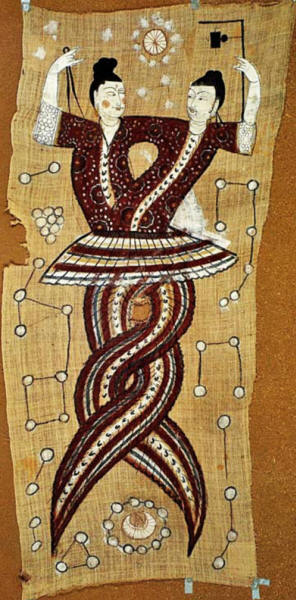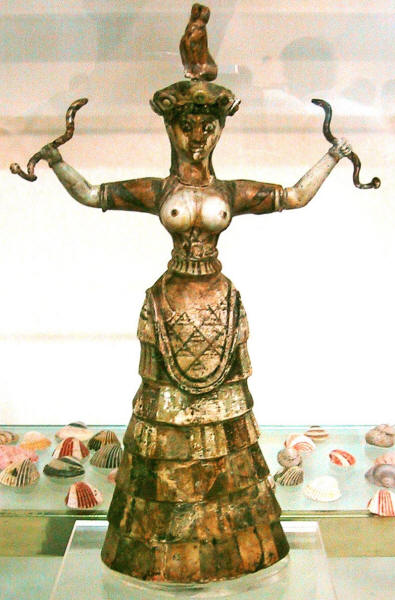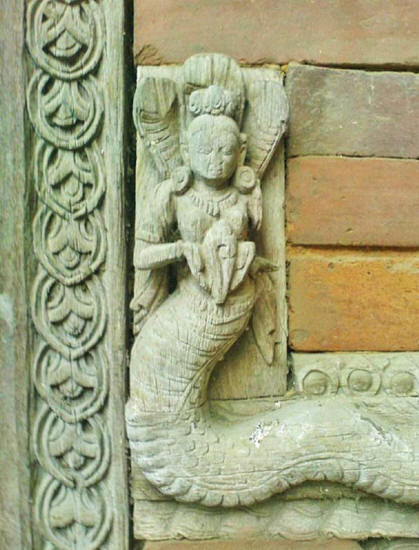|
03 December, 2014 from Ancient-Origins Website
Loki's brood Hel, Fenrir and J÷rmungandr. By Emil Doepler, 1905 (Wikimedia Commons)
The 'light' that appeared was metaphorically defined as a serpent called 'Kundalini', coiled at the base of the spine to remain dormant in an unawakened person.
Divinity or awakening
one's Godhood and latent abilities came with the rituals and
teachings brought by the serpent people.
So, if, at the dawn of
man's creation we have a pair of serpent-like beings who created us,
then those of the serpent cult must have been their direct
descendants, either by blood or by spirit. Fu Xi and Nu Wa, the mythological serpents who created humans in Chinese mythology
(Wikipedia)
According to Zecharia Sitchin, he dwelt in Magan, or what is known to us as Egypt, leading theorists to believe he was Thoth who formed a mystery school propagating ideas of self-improvement and enlightenment, furthering his father's deeds and philosophy.
If Enki and Ningizzidda ruled over Magan as is claimed, then that school would have been a beacon attracting all who wished to gain knowledge, backed by the power and might of Magan.
Is there any other proof to that theory?
It was claimed at the Council of Nicea that,
There was a Great White Brotherhood (named for their raiment), a prominent mystery school in Karnak.
A branch of it became the
Egyptian Therapeutate who in Judea were known as the
Essenes. Jesus, being an Essene, most likely was
initiated in Egypt at this mystery school, rising up the levels
until he became a 'Master'.
The Sumerian God, Ningizidda, represented as the double headed Snake coiled into a double helix (highlighting the duality in nature), flanked by two gryphons
(Wikipedia)
Those who followed the serpent ideology would have been concerned with maintaining relevance while faced with constant change, new religions, and potential threats to their own land which was wealthy.
To both protect themselves and to encourage people to follow their belief system, they sent out emissaries (the 'Shining Ones') and we find tales of these Shining Ones the world over.
To simple hunters and fishermen they seemed like gods.
They did not come to
conquer the lands, but rather to aid the people, teaching them how
to cultivate crops, heal their sick and injured, and read the stars.
...and the serpent deities who were beautiful women associated with trees and lakes.
The Snake Goddess of Egypt, Wadjet, was protector of the land, kings, and women in childbirth.
In Minoa, the Snake Goddess was addressed as A-sa-sa-ra-me and was related to the Hittite Ishassara, the Khmer Apsara and the Canaanite Asherah.
Pre-Christian Ireland,
Scotland and England also worshipped the serpent. The Minoan Snake Goddess
(Wikimedia Commons)
To that end, politically advantageous marriages were arranged with the emerging ruling families.
A serpent prince or princess marrying into the family would bring trade, wealth, knowledge on how to form a coherent society and the secrets known only to the cult, which would then be passed down to the resultant children.
It was this well of knowledge that gave the new ruling family the advantage over their people and allowed them to claim 'Divinity' - or superiority over all others.
Yet most of these marriages did not end happily.
Carving of a Naga, one of many wrought from wood or stone
to be found throughout Asia
Zeus seduces Olympias, Giulio Romano, 1526 Palazzo del Te, Mantua, Italy
(Wikipedia)
Why, when the serpent beings were known for their beauty and brought such advantages, did the marriages often end so badly?
Perhaps the serpent princess found herself missing her home.
She also found herself dependant on her husband's good will to ensure she was welcomed into society and often faced censure, suspicion of her foreign influences and outright jealousy.
Unable to form friendships, she was ostracized and should her husband's affection waver, those who sought her downfall would pounce.
In many cases, the princess simply returned home, leaving her children behind. In others, she or her husband would die.
Yet she is remembered
through her children, who were born with greater strength and
intelligence than those around them, enabling the family to assert
its claim that they had been granted the divine right to rule by the
gods, the superior children proof of the gods' favor.
|







